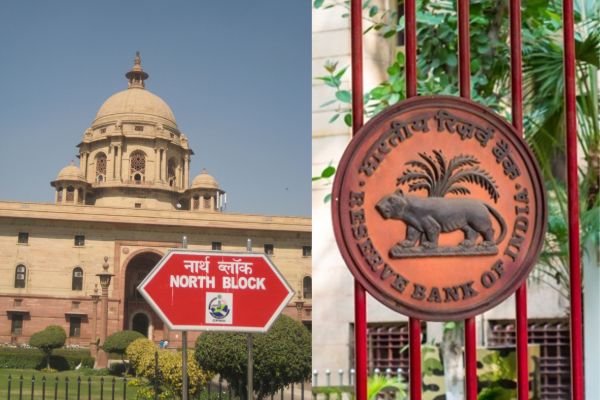.png)

By Babuji K
Babuji K is a career central banker with 35 years at RBI in exchange rate management, reserve operations, supervision, and training.
September 9, 2025 at 2:56 PM IST
India’s policymakers have reached for a rare, synchronised playbook. The Reserve Bank of India’s aggressive easing cycle and the government’s sweeping GST reforms arrived within months of each other, pitched as instruments of growth and stability. Beneath the veneer of coordination lies a more urgent reality: these have become defensive moves against the US’ punitive 50% tariff on Indian exports. What looks like macroeconomic fine-tuning is in fact a form of crisis management.
Transmission Troubles
The RBI has slashed the repo rate by a full percentage point this year, taking it down to 5.5%. A 100-basis-point cut in the cash reserve ratio has pumped nearly ₹2.5 trillion into the banking system, creating an abundance of rupee liquidity.
Yet for all the firepower, the transmission has been halting. Through May, the weighted average lending rate on new loans barely budged, hovering around 9.2–9.4%. Only in June, after a larger 50-point cut, did lending rates fall to 8.6%—their lowest in almost three years, reflecting lags in policy transmission. By July, paradoxically, they edged back up as banks priced seasonal credit demand from MSMEs ahead of the festive season.
Deposits told a similar story. Weighted average term deposit rates fell in tandem, dipping to 5.75% in June from 6.30% in May. Savers responded by shifting into higher-yielding small-savings schemes, tempering banks’ ability to cut further. This underlines a familiar truth: monetary easing in India rarely flows cleanly through to households and firms, slowed by balance-sheet constraints and alternative savings vehicles. Once inflation and taxes are considered, the real rate of return for savers falls even further.
Fiscal Strain
If monetary policy’s channel is clogged, fiscal policy’s path is more direct, though slower to yield results. GST Council’s September reforms collapsed the four-tier rate structure into two: 5% and 18%, with a punitive 40% slab for luxury and sin goods. Economists expect the reset to shave a full percentage point off retail inflation and add 60 basis points to growth. The timing is no accident: a consumption boost ahead of the festive season is politically useful, and economically vital when exports face Washington’s tariff wall.
Yet GST’s transmission is hardly instantaneous. Old inventories will take time to clear, labels must be reprinted, and many consumers remain unaware of their entitlements. Traders have little incentive to pass on the full benefit quickly, particularly with the anti-profiteering watchdog disbanded. It may take months before shoppers see lower MRPs on shelves. Meanwhile, the government must reckon with a revenue hole estimated at ₹480 billion. Bond markets are already nervous. Ten-year government yields have climbed from 6.35% in July to around 6.5% in early September. State development loans remain higher still, with Assam’s 2035 paper quoted at 7.63%. Investors see the paradox clearly: even as policy loosens, borrowing costs tighten.
This is the core tension. A country can cut interest rates and taxes, but if financial markets price in fiscal slippage, the net effect on credit and investment may be weaker than intended. India is living this contradiction. The adverse effect on the external front, given weaker export earnings from tariffs, is already visible in the exchange rate. RBI’s $695 billion in reserves provides a buffer against volatility, keeping the rupee competitive. That cushions the trade shock, but cannot offset second-round effects such as unemployment or the slow pace of forging new trade partnerships.
On the other hand, GST reforms cannot indefinitely cover the gap between lost GST revenues, higher borrowing costs, and the fiscal demands of a slowing economy. How the government bridges this gap is critical.
The synchronised stance should not be dismissed. Rarely have monetary and fiscal levers been pulled in such unison, albeit with a little lag. GST reforms can offer households relief from high taxes and firms more affordable credit, if transition is followed quickly by transmission. They also send a powerful signal that the government and RBI are in sync. For an economy confronting both external tariffs and domestic demand weakness, such coordination is not only just be desirable but essential.
Will the GST’s consumption boost outweigh its fiscal drag? Will banks accelerate lending once liquidity has stabilised, or will credit growth remain hostage to risk aversion? And will bond markets punish the government more severely if revenues fall short? These are not theoretical worries. In the last cycle of GST tweaks, consumer gains were patchy while fiscal gaps persisted for years.
Policy coordination buys time, but it does not resolve structural weaknesses in India’s transmission mechanisms. Interest rates still pass through unevenly, with lags and reversals. Tax cuts can spur demand, but without strong enforcement, their benefits may not reach the final consumer quickly. And bond markets remain the ultimate arbiter, tightening conditions even as policy eases.
India’s double act is bold and necessary. Yet its toughest test lies ahead. If tariffs linger, deficits widen, and transmission falters, the room for manoeuvre will shrink quickly. Coordination alone cannot carry the economy; structural fixes must follow, or risk turning a synchronised dance into a stumble.




